Portuguese Upside Down Pineapple Cake
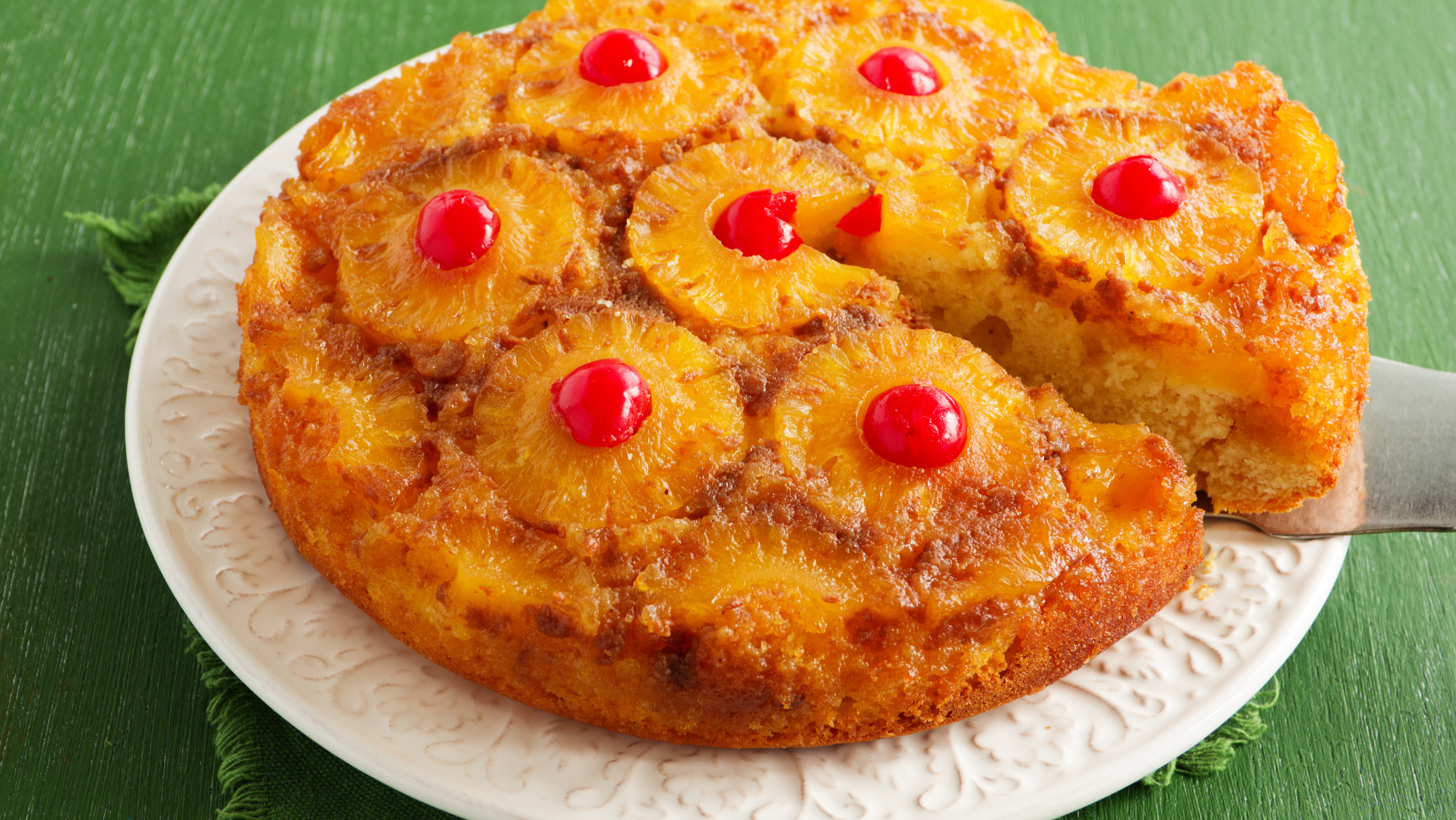
This classic Portuguese pineapple upside-down cake might just be the closest thing to a slice of heaven. With its buttery richness and sweet fruit topping, it’s a love story on a plate. Imagine the soft golden cake layered with caramelized pineapple rings, each bite taking you on a delightful culinary journey. That’s the magic of our Portuguese Pineapple Upside-Down Cake Recipe. Every single bite is a delightful embrace of juicy pineapples caramelized to perfection and a cake so tender, it hugs your taste buds.
The ingredients? Simple things you probably already have in your pantry. The process? A joyful dance in the kitchen that even baking newbies can join in on. Dive into this Portuguese upside-down pineapple recipe with me, and together, let’s turn our kitchens into gateways to the soulful Portuguese shores. Trust me, every slice of this pineapple cake also fancied as bolo da ananás is a sweet slice of love, and I can’t wait for you to taste it!
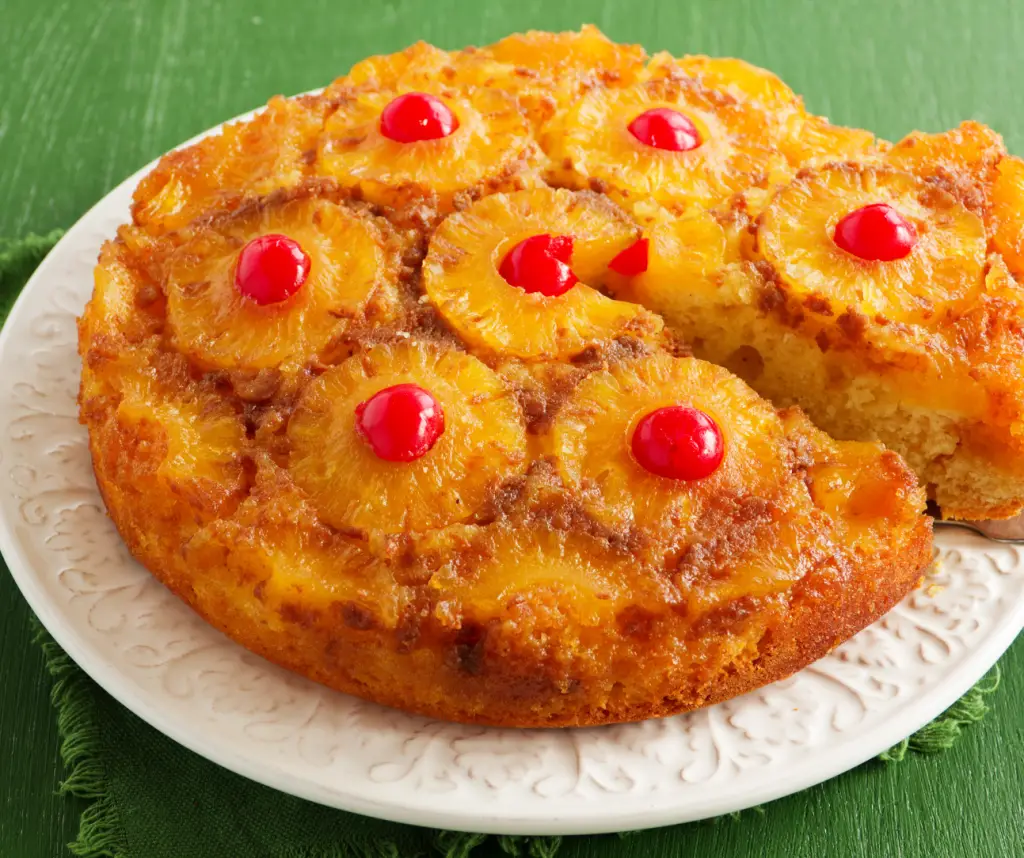
Traditional Portuguese Upside Down Pineapple Cake
Growing up in Ecuador, the kitchen was always a haven of scents and flavors. I fondly remember my Abuelita meticulously crafting traditional recipes handed down through generations. We had desserts that took you on a journey – from the cool Andes mountains to the warm shores of the Pacific. There was an inherent richness, not just in taste, but in stories and memories that every dish held. But life, you know, it has its own plans! It took me far away, across the ocean, to beautiful Canada, where I found love in the arms of my Portuguese husband who was as passionate about his traditional pastries as I was.
Our first time baking together was this special traditional pineapple upside-down cake. I told him tales of the pineapples that crowned our Ecuadorian desserts, and he reminisced about his grandmother’s timeless baking methods. Hand in hand, blending our memories and traditions, we birthed a new delight, this Portuguese Pineapple Upside-Down Cake that has now been a traditional recipe in our family for the past fifteen years.
This cake is not just a traditional Portuguese dessert, it’s a symbol of our journey, a piece of our souls, a testimony of love, and a testament to the wonders of blending two worlds in one bite. It’s my hope that when you bake this cake, you don’t just taste the flavors of Portugal, but also feel the love and history that it carries for us.
Here’s Why You’ll Absolutely Adore This Portuguese Pineapple Upside-Down Cake:
- A Taste of Portugal: Infused with traditional Portuguese baking techniques, this cake provides an authentic flavor journey. It’s a little slice of Portugal and the Azores in every bite.
- Balanced Sweetness: The cake uses sugar for a consistent sweetness throughout, which is beautifully complemented by the caramelized pineapples. This combination ensures a harmonious blend of refined and natural flavors.
- Effortless Baking: One of the true joys of this recipe is its simplicity. Crafted with both novices and seasoned bakers in mind, the steps are clear, straightforward, and easy to follow. Whether you’re a first-timer or a seasoned baker, you’ll find joy in effortlessly bringing this cake to life. So, roll up those sleeves and let the magic begin!
- Picture-Perfect Presentation: The luminous hue of caramelized pineapples paired with the cake’s golden brown gives it a visually stunning appeal. It’s a dessert that’ll stand out on any table and draw everyone’s attention.
- A Delightful Fusion: While its roots are deeply anchored in Portuguese baking, the subtle touch of pineapple is a nod to tropical flavors, making it a delightful fusion that surprises and pleases the palate.
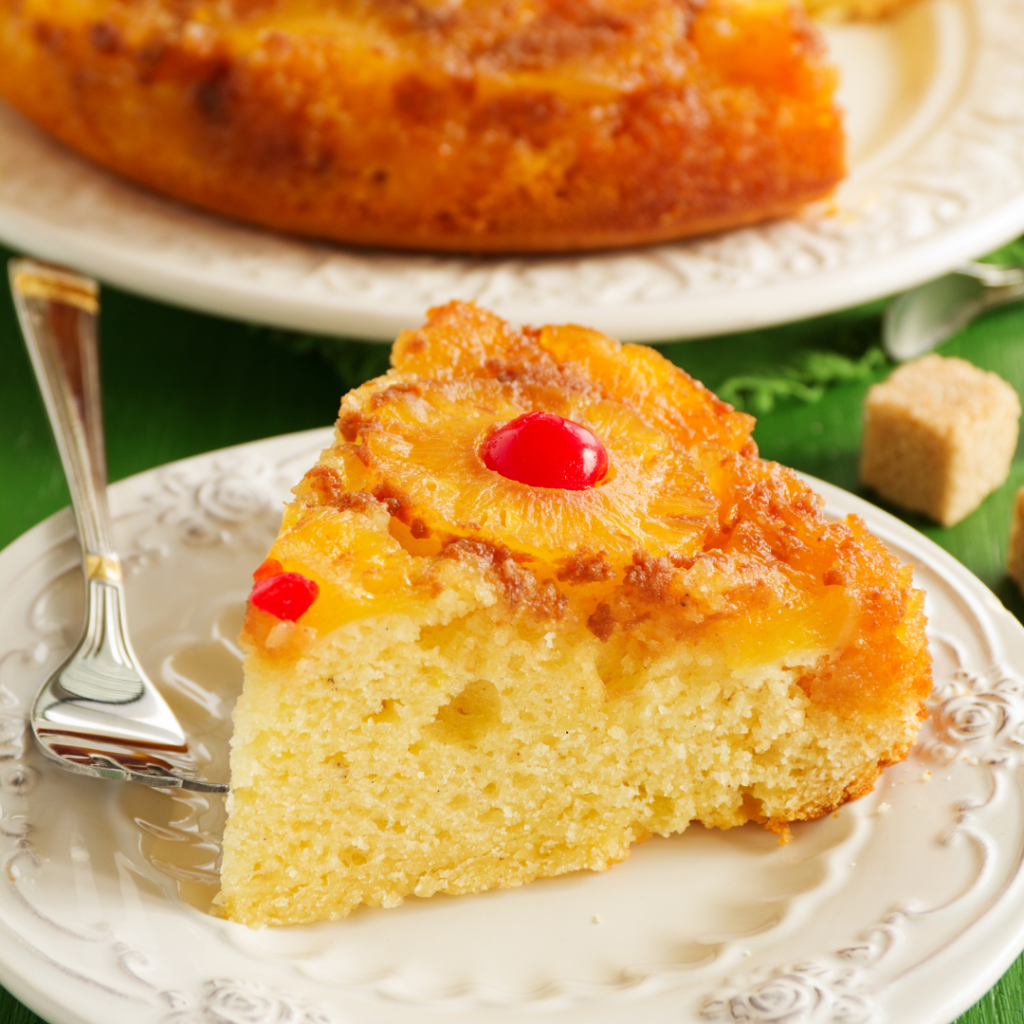
TIPS & TRICKS TO PERFECT YOUR PORTUGUESE PINEAPPLE UPSIDE-DOWN CAKE
Here are a few tips and tricks to help make the best upside-down pineapple cake, Portuguese Style…
- The Pineapple Perfection: While this recipe uses canned pineapple rings because they are quick and convenient, using fresh pineapple slices can elevate the cake’s flavor profile. If opting for fresh, ensure the pineapple is ripe for optimal sweetness and juiciness. Additionally, patting the slices dry will prevent excess moisture in the cake.
- Golden Caramel Consistency: When creating your caramel base, watch the sugar and butter mixture closely. You want a smooth, amber-colored consistency. Removing it from the heat just as it turns golden ensures a perfectly caramelized base without any bitter burnt notes.
- Cake Batter: For an even fluffier cake, ensure all your wet ingredients are at room temperature. This promotes better mixing and even baking. When combining the wet and dry ingredients, mix just until blended to keep the cake’s texture light and airy.
- Check for the Perfect Bake: Ovens can vary. To check the doneness of your cake, insert a toothpick or a thin skewer into the center. If it comes out clean or with just a few crumbs, it’s ready. Avoid overbaking, as this can make the cake dry.
- Flipping Over The Cake: After baking, allow the cake to cool in the pan for about 10-15 minutes. This helps the caramelized layer to set a bit. When you’re ready to flip, place a serving plate over the pan, hold them together tightly, and then invert. Doing this confidently ensures the pineapple and caramel layer stays intact.
Key Ingredients For Upside-Down Pineapple Cake
(Just a heads-up: you’ll find the exact measurements for the ingredients in the recipe card below.)
- Canned Pineapple Slices: A convenient choice for this classic cake, canned pineapple slices bring both sweetness and a moist texture. Plus, don’t forget to utilize the juicy syrup they come in.
- Maraschino Cherries: These vibrant, sweet cherries don’t just add a pop of color but also a delightful contrasting flavor nestled between pineapple slices.
- All-purpose Flour: The backbone of our cake, it provides structure ensuring the cake holds up to the moist pineapple and caramel layer.
- Baking Powder: Our primary leavening agent, baking powder gives our cake the ideal rise, creating a light and fluffy crumb.
- Salt: An unsung hero, salt not only balances the sweetness but also enhances the flavors of the other ingredients.
- Cinnamon: This spice gives a nod to traditional Portuguese desserts, offering a warm and aromatic essence to our cake.
- Unsalted Butter: For both the batter and the caramel, softened unsalted butter lends richness and a velvety texture. Creaming it with sugar ensures a tender crumb reminiscent of classic European cakes.
- Granulated Sugar: While the white granulated sugar in the batter tenderizes our cake, it also plays a starring role in forming that beautiful amber-hued caramel for our pineapple base.
- Eggs: Binding our ingredients together, eggs also introduce moisture and richness, ensuring each bite is soft yet substantial.
- Vanilla Extract: A dash of vanilla extract brings a fragrant aroma and a subtle depth of flavor, complementing the tropical pineapple beautifully.
- Milk: Milk introduces necessary moisture, ensuring our batter reaches the perfect consistency, leading to a lusciously moist final product.
- Lemon Zest: A hint of citrus zest to infuse our cake with a bright and zesty note, often found in traditional Portuguese baked goods.
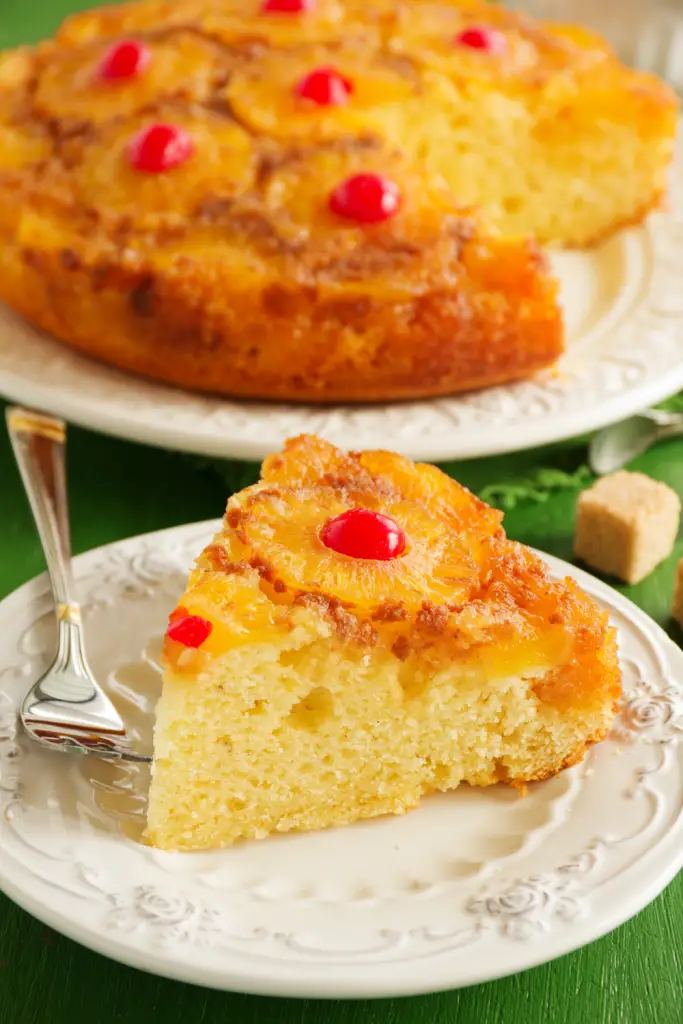
How To Make Portuguese Upside Down Pineapple Cake
- Preparation First: Preheat your oven to 350°F (177°C) to ensure a warm and welcoming environment for your cake. Butter your 9-inch round cake pan for an easy release later on.
- Crafting the Topping: In your prepared cake pan, melt the unsalted butter, ensuring an even coat across the base. Sprinkle the light brown sugar evenly over the butter. This will create a caramel-like base for your pineapples and cherries. Next, arrange your pineapple slices, ensuring an even distribution, and place a maraschino cherry inside each pineapple ring and in spaces around them.
- Mixing the Dry Ingredients: In a large mixing bowl, sift together the all-purpose flour, cinnamon, baking powder, baking soda, and salt. This ensures a lump-free and well-mixed dry base for your batter.
- The Wet Ingredients: In another bowl, cream together the unsalted butter and granulated sugar until the mixture is light and fluffy. Incorporate the eggs one at a time, mixing well after each addition. This ensures a consistent and smooth texture. Introduce the vanilla extract and fresh lemon zest for added flavor depth.
- Combining the Two: Gently fold in the dry ingredient mixture into your wet ingredients, alternating with the milk. The goal is a smooth, pourable batter.
- Assembling the Cake: Carefully pour your batter over the pineapple and cherry arrangement in the cake pan, ensuring an even spread.
- Baking: Place your cake in the oven and allow it to bake for 40-45 minutes. You’ll know it’s done when the surface is golden brown, and a toothpick inserted in the center comes out clean.
- Cooling & Serving: After baking, let the cake cool in the pan for about 10-15 minutes. Once it’s cool enough to handle, invert it onto a serving plate. The pineapples and cherries should now be on top, showcasing a beautiful and classic pattern.
FAQs: Perfecting Pineapple Upside-Down Cake
What Is The Trick To Flipping Pineapple Upside-Down Cake?
Flipping a pineapple upside-down cake can be a bit nerve-wracking, but with a few tricks up your sleeve, you can ensure a successful, clean flip every time:
- Let it Cool…But Not Completely: Wait about 10-15 minutes after removing the cake from the oven before flipping it. This gives the cake a bit of time to set, making it less likely to fall apart, but ensures the topping is still warm and fluid, allowing for an easy release.
- Loosen the Edges: Before you flip, use a butter knife or a thin spatula to gently run along the edges of the cake to make sure they aren’t sticking to the sides of the pan.
- Use a Flat Plate or Cake Stand: Ensure the plate or stand is slightly larger than the cake pan. Place it over the top of the cake pan, then flip the cake pan and plate together, holding them firmly.
- Confidence is Key: When it’s time to flip, do it with a swift, confident motion. Hesitation or doing it too slowly can lead to breaks or the topping not coming out cleanly.
- Check the Pan: After flipping, give the pan a slight lift to check. If you notice any fruit sticking to the bottom of the pan, gently remove it and place it back on the cake.
- Use Parchment Paper: If you’re particularly concerned about the cake sticking, consider lining the bottom of your cake pan with a circle of parchment paper. While it’s not traditionally used in pineapple upside-down cake recipes, it can provide an extra layer of assurance against sticking.
HOW DO YOU KEEP PINEAPPLE UPSIDE-DOWN CAKE FROM GETTING SOGGY?
To prevent a pineapple upside-down cake from becoming soggy, follow these steps, you can enjoy a pineapple upside-down cake that has a perfect balance of moisture and fluffy cake texture!
- Drain the Pineapple Well: Before placing the pineapple slices onto your baking dish or pan, make sure to drain them properly. If using canned pineapple, let the slices sit on paper towels to absorb any excess syrup or juice.
- Avoid Overly Juicy Fresh Pineapple: If using fresh pineapple, be aware that it can sometimes be juicier than its canned counterpart. Consider patting the slices with paper towels to remove excess moisture.
- Limit Brown Sugar-Butter Mixture: While this caramel-like layer is delicious, using too much can make the cake too wet. Stick to the recipe’s recommended quantities.
- Bake Until Fully Set: Ensure the cake is fully baked by testing its center with a toothpick. If it comes out with wet batter on it, give the cake more time. A fully baked cake will help prevent a soggy texture.
- Cool Before Flipping: Allow the cake to cool for the recommended time (often 10-15 minutes) after baking. This brief cooling period helps the cake set up a bit more and reduces the chances of the topping making the cake soggy when inverted.
Can You Substitute Milk For Water For Upside Down Pineapple Cake?
Absolutely! When making pineapple upside-down cake, replacing water with milk can enhance its texture and flavor:
1. Texture & Flavor: Using milk instead of water will give your cake a slightly denser, richer texture. The fats present in milk add a hint of creaminess that’s utterly delicious.
2. Browning: Do note that milk might cause your cake to take on a golden hue faster than water. This is due to the protein and sugars in milk. To ensure it doesn’t over-brown, you might want to check on it a bit earlier and tent it with foil, if necessary.
3. Retaining Pineapple Flavor: If the original recipe suggests using the juice from the canned pineapples as the water content, substituting it entirely with milk might dilute the pineapple essence in the batter. A blend of pineapple juice and milk could be the key to balance richness and flavor.
4. The Swap: It’s simple – for this pineapple upside-down cake recipe, use the same amount of milk as the water required.
Here Are More Great Portuguese Dessert Recipes To Love
- Honey Sponge Cake
- Sweet Rice Pudding
- Pasteis De Nata Custard Tarts
- Classic Rice Cake
- Traditional Milk Tarts
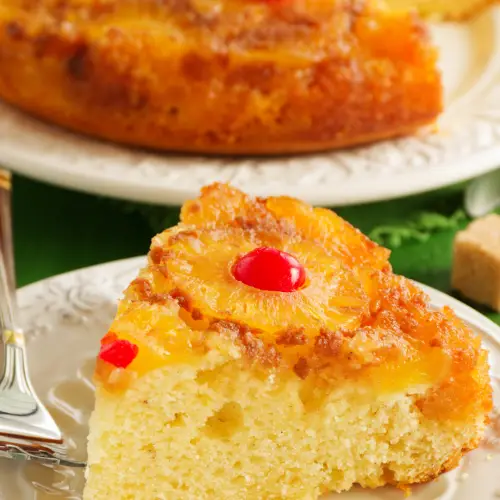
Portuguese Pineapple Upside-Down Cake
Ingredients
For the topping:
- 1/4 cup unsalted butter (55 grams)
- 2/3 cup light brown sugar (135 grams)
- 7-8 pineapple rings canned or fresh
- 6-8 maraschino cherries
For the cake:
- 1 1/2 cups all-purpose flour (200 grams)
- 1/2 teaspoon cinnamon (1.5 grams)
- 1 teaspoon baking powder (5 grams)
- 1/4 teaspoon baking soda (5 grams)
- 1/2 teaspoon salt (2.5 grams)
- 1 cup granulated sugar (200 grams)
- 1/2 cup 1 stick unsalted butter, room temperature (113 grams)
- 3 large eggs (150 grams) room temperature
- 1 teaspoon vanilla extract (5 grams)
- 2/3 cup whole milk (160 grams)
- Zest of 1 lemon
Instructions
- Start by setting your oven to 350°F (177°C).
- Melt the unsalted butter in a 9-inch round cake pan and spread evenly. Sprinkle the light brown sugar over the melted butter. Arrange the pineapple rings and place maraschino cherries inside each pineapple ring and in the gaps.
- In a mixing bowl, sift together the flour, cinnamon, baking powder, baking soda, and salt. In another bowl, cream the butter and granulated sugar. Add eggs one by one, then the vanilla extract and lemon zest. Gradually mix in the dry ingredients, alternating with the milk, until a smooth batter forms.
- Pour the batter over the pineapple and cherry setup in the cake pan, ensuring an even spread.
- Bake for 40-45 minutes or until a toothpick comes out clean from the center.
- After baking, let it cool for about 10-15 minutes, then invert onto a plate.
- Slice, serve, and relish the traditional flavors of this Portuguese-inspired treat!
Notes
- Fruit Placement: Arrange your pineapple slices and cherries in a pattern or design of your choice. If you want a classic look, place one cherry in the center of each pineapple ring.
- Pan Type: This recipe works best with a deep, round cake pan or pie dish to accommodate the caramelized topping and ensure an even bake for the cake.
- Butter Temperature: Always ensure your butter is at room temperature. This allows for a smoother, more unified batter.
- Pineapple Juice: Don’t discard the juice from the canned pineapple. It can be reserved for other uses or even as a refreshing drink.
- Cake Storage: Store any leftovers in an airtight container. This pineapple cake tastes even better the next day as the flavors meld together.
- Flavor Variations: For a hint of spice, consider adding a dash of nutmeg to the batter.
- Serving Suggestion: While delicious on its own, this cake pairs wonderfully with a scoop of vanilla ice cream or a dollop of whipped cream.
- Cooling is Key: After baking, let the cake rest for at least 20 minutes before inverting to ensure the topping settles properly.
- Customize: Feel free to add nuts like walnuts or pecans to the caramel topping for an added crunch.
